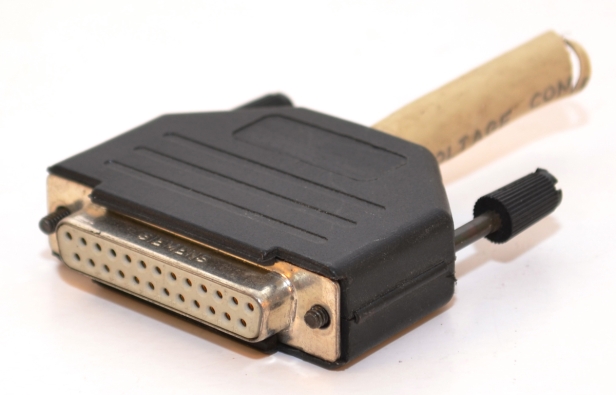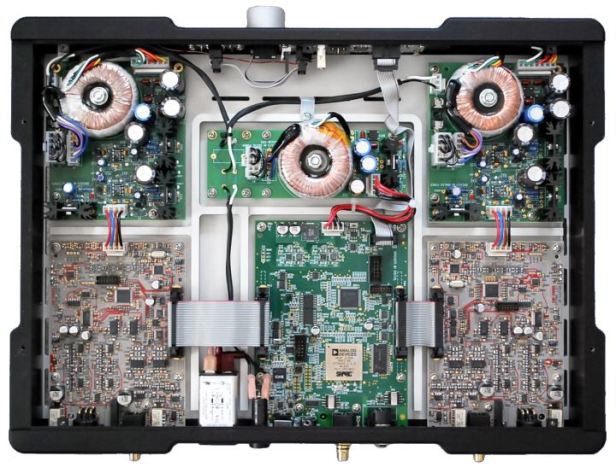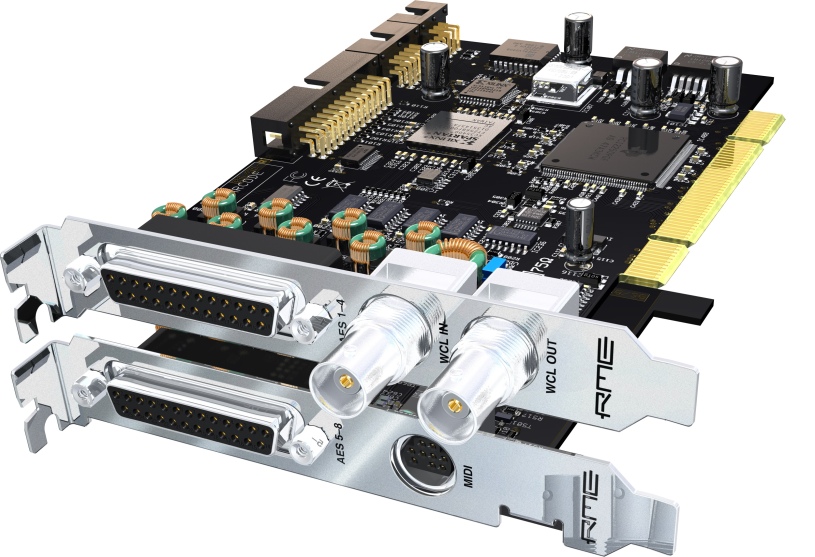The featured image is an RME HDSP AES-32 PCI-E sound card.
In my system, I have opted to go for a Merging+ NADAC and RME Fireface UC. There are of course, other options which I considered. Some of these may work better for you.
Before you choose, here are a few considerations for system design:
1. Single ASIO driver. The most basic requirement is that you have a single ASIO driver which is capable of driving all the DAC’s simultaneously. Simply plugging four USB DAC’s into four USB ports will not work*!
* One exception is Mytek, which has a Windows driver capable of driving four Mytek DAC’s plugged into a USB hub. Details here.
2. Clock synchronization. The next requirement is that the DAC’s need to be clock synchronized. Ideally, you have a single multichannel DAC so you will not have to worry about the problem of clock synchronization. However, if you choose to use multiple DAC’s, you will need a way to synchronize them. The reason is because of clock drift.
Suppose we have a clock which is accurate to 18ppm (parts per million), at a sample rate of 44.1kHz. This means that for every 1 million ticks, the clock will drift 18 ticks. At 44.1kHz, one tick is (1/44100) = 0.023ms. Meaning, it will drift by (0.023ms * 18) = 0.41ms per second. Doesn’t sound like much, but in one hour it will have drifted by (0.41*60*60) = 1.5 seconds. If you have two clocks, the drift is doubled – 3 seconds. You will definitely hear a difference between your drivers if they are producing sounds 3 seconds apart. In fact, you can hear a difference in as little as 5ms apart – it will take about 20 seconds of music before the drift becomes apparent enough for you to hear it.
For this reason, you need a clock with vanishingly low clock drift, or better still – a master clock to keep all the DAC clocks synchronized.
3. Sufficient output voltage. If you plan to send signal directly to your power amps, you will need enough output voltage to drive your amps, otherwise you will need to find yourself a multi-channel preamp, which is an even rarer beast than multichannel DAC’s. Most multichannel DAC’s output between 5-6V, which you might think should be sufficient, but read the next point first. Most audiophile DAC’s output about 2.1V, which is in no way enough.
4. Individual channel trim. If you are running an active multiway system with dissimilar power amps, and into different drivers of varying sensitivity, then you will need a way to volume match each channel. This is related to point (3) above. In my particular system, my horns are 15dB louder than the bass cabinets (a consequence of trying to match a high sensitivity horn with low sensitivity bass drivers). Once the channel trim on the NADAC is adjusted to volume match all the drivers, I no longer have enough voltage output to drive the system to adequate loudness. I was therefore forced to purchase a preamp for the sole purpose of boosting the gain on the bass cabinets to match the horns, an irritating and costly necessity.
In this article we will discuss using a PCI-E Sound Card to Multiple DAC’s, like this:

(Not illustrated in this diagram is the master clock that ties all the DAC’s together).
With this option, you install a PCI-E sound card in your PC. A single ASIO driver takes input from as many channels as you want (however we want only two) and routes digital output out the back of the card.
These sound cards typically use D-sub connectors or ADAT. If you want to connect it to your typical audiophile DAC, you will have to buy a breakout cable or a breakout box which converts the D-sub connector to XLR (AES/EBU). Needless to say your DAC must accept AES/EBU input.
Both these connectors are pro audio standards which are unfamiliar to typical audiophiles. A D-sub connector looks like this: 
D-sub connectors may have different output or pinout standards. For example, here is a screen shot from the RME HDSP AES-32 manual describing the different pinouts for different standards of connector (Tascam/Digidesign, Yamaha, and Euphonix). It is buried in one of the appendices in a 300 page manual:

I am a typical male, in that I don’t normally read manuals. But in this case, I am glad I did, otherwise I could potentially have ordered the wrong cable! For typical audio use, you want the Yamaha pinout.
ADAT is a pro audio standard that sends 8 or more channels of audio down a single fibre optic cable. Some PCI-E sound cards might support this standard.
Regardless of which you choose, you will need some way of converting the output of your sound card into a format that your DAC will understand. One example is the RME BOB-16 which converts D-sub to XLR. Another option is the Yamaha AES breakout snake.
So, how do you take measurements? Depending on which you choose, these cards may have an internal ADC or more likely a digital input. Even if it did have an internal ADC, it would for sure not include 48V Phantom power for your microphone. You could choose a USB microphone, but it is better to buy a microphone preamp which has 48V Phantom power and built-in AD conversion. Note that the RME has word clock outputs and inputs, so it is possible to synchronize the card to the AD converter on the microphone preamp.
Examples of suitable PCI-E sound cards:
Advantages. High quality two channel DAC’s can be found in abundance. Most of these DAC’s have more purist designs than nearly all the multichannel DAC’s on the market so far. “Audiophile” DAC’s typically have these features that you won’t see on a multichannel DAC:
- Linear power supplies. Sometimes, multiple power supplies to power individual channels, or separately power the digital and analog stages. Examples: Bricasti M1, MSB, DCS. You will very rarely find a switch mode power supply on a high end DAC.
- Boutique DAC chips or custom DAC chips. ALL multichannel DAC’s on the market at the moment use off the shelf DAC chips in the cheapest and nastiest configuration possible. In contrast, in the audiophile world, you will typically see ground up design with discrete components (e.g. Lampizator ladder DAC, MSB ladder DAC, DCS Ring DAC), or FPGA based programmable DAC’s (e.g. Playback Designs, Chord).
- Separation of digital and analog circuitry.
- High quality output stages. If an audiophile DAC uses op-amps, at the very least they will use a pair in a balanced configuration, or they will bias it towards class A. Some have more complicated output stages with valves. In contrast, nearly all multichannel DAC’s have very simple output stages.
- High quality clocks with published jitter specifications. Examples: MSB femtoclock, DCS clock, Esoteric G0Rb Rubidium clock, Antelope 10M Rubidium clock.
Of course, whether these features are important to you depends on your personal beliefs about the audibility of these things. I have certainly met some flat earthers who say with a straight face that all DAC’s sound alike.
But do bear this in mind – any audiophile DAC that lives in the high end stratosphere will employ all these features and more. Even if you believe that these features are not necessary or do not contribute to the sound, you should also agree that DAC’s that omit all these features should be cheaper. After all, what is the point of a DAC based on a Sabre ESS9008, single SMPS, and with none of the other high end features I mentioned but priced to compete with the likes of purist DAC’s like MSB and Playback Designs? (I am looking at you, Merging NADAC).

The picture above is of a Bricasti M1 DAC, which retails for USD$7800. Note – triple linear PSU’s, each mono channel is separate (in a nice touch, the circuit boards are mirror images of each other), the digital section is separate, the clock and I/V conversion are performed right next to the DAC chip.
You will not find a multichannel DAC built like this. Ever. Sadly, the case with some multichannel DAC’s like the Merging NADAC is this – you end up paying MSB prices but you get a piece of gear built using the cheapest parts on the market. If you omit high end parts and design, you should not charge high end prices.
Disadvantages.
- Buying multiple high end DAC’s is expensive.
- These DAC’s typically have insufficient output voltage to drive power amps directly. Most of them were designed with the assumption that the user would be using a preamp.
- Most of these DAC’s do not have clock inputs, so it is not possible to synchronize them. The DAC’s that do have clock inputs tend to be expensive.
- Nearly all these DAC’s do not have integrated volume control, making it necessary to control the trim of the DAC’s via the control interface/mixer of the pro audio card.
- If you want DSD output, none of these cards will support DSD output. They will probably support DoP (DSD over PCM) output, but I have not tested this. Needless to say, if you choose DoP, you will need to make sure your DAC is DoP compatible.
- If you have never seen a mixer console, the software interface for these pro audio cards is quite intimidating. Even installing the card and designing the system is intimidating. It is by no means plug and play. Be prepared to spend a lot of time studying the manual.

